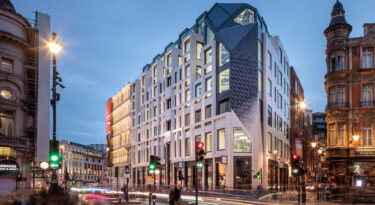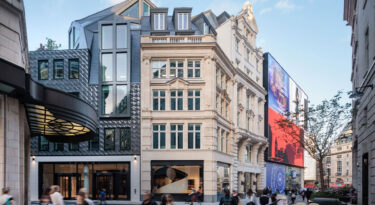Building for the future around the historic Piccadilly Lights


The built environment and construction sector accounts for 38% of global carbon emissions and it has been estimated we build the equivalent of a city the size of Paris every week across the world.
By building green, we can mitigate the effects our buildings have on climate change and reduce our overall impact on the environment.
In this blog, Peter Jones, Wates Senior Sustainability and Environmental Advisor, shares how, together with client Landsec, Wates has delivered a sustainable workplace with an impressive biodiversity net gain and embodied carbon reduction at the flagship building project behind the lights at Piccadilly Circus: Lucent.

My passion for sustainability goes back to when I was at school learning about the natural environment and our impact on it. Since then, I have always wanted to be part of creating a legacy of positive change, ensuring the well-being of our planet.
I joined Wates last year after 13 years in the industry working on some really exciting projects in and around London, most recently redeveloping large brownfield sites which were heavily contaminated in regenerative areas and turning them into new parks and housing.

Being asked to lead on environment and sustainability on such a high-profile development as Lucent for my first project with Wates, and working with a client which was equally as passionate as us, has been a welcome challenge and one that I have thoroughly enjoyed.
The commercial market is demanding more sustainable workplaces for the future and we must also ensure we are building in a way that meets the climate agreements we have committed to as a country – providing more energy efficient buildings and responding to the cost-of-living crisis.
Studies indicate that a sustainable building can improve the health and wellbeing of its occupants and increase productivity by up to 11%. Lucent is a perfect example of this. The design embraces latest thinking on how light and natural environment can support wellbeing and productivity, with 23 green spaces and over 600 plants. Shower and changing facilities have also been provided to encourage the building’s occupants to be more active and use alternative ways to get to work, such as cycling.
Houseplants have been proven to reduce stress levels and blood pressure, which can make people up to 15% more productive. This principle is being tested to the max at Lucent – it’s a place literally built around nature, with a mature Magnifica tree in the centre. A 222 sq.m. Winter Garden is designed to improve occupants’ connection to the natural environment with mature trees and perennials to produce oxygen. So we have created a tranquil green space – something of a rarity in central London -with additional health, environmental, and economic benefits.
My personal passion is exploring how we can implement a circular economy and use our existing building stock more efficiently. As an industry we can do much to re-use materials and resource efficiently to reduce waste. We need to design buildings for adaptability and look to retain some of the existing structure rather than demolishing and starting from scratch. Fortunately, there were original features on Lucent that we were able to retain. Some of the façade work has been repaired and reinstated. It is also the first project I have worked on to achieve FSC project status meaning practically all of the timber, including the temporary timber used, was FSC certified, which has such a positive impact on the environment.
In my view, Landsec has been a great client to work with in terms of practicing what they preach and truly wanting to be a sustainable developer. They have been really hands-on, and we have worked collaboratively throughout the project, meeting monthly to discuss ideas and run through the different sustainability targets we wanted the project to meet. If they had a request, we came to the table with a solution. One example was when we were asked to look at how we could use materials with a lower embodied carbon value. Having already significantly reduced carbon during RIBA Stages 1-3 by designing lean and specifying low carbon materials, Landsec set a 15% embodied carbon reduction target from RIBA Stage 3. We worked with our supply chain and consultants to find alternatives for traditional concrete and steel which were more sustainable, with higher recycled contents. The concrete we selected saved 150 – 170 tonnes in CO2 emissions.
Lucent has so many impressive attributes, but for me, the most exciting achievement was its biodiversity net gain. Being located in such a densely packed urban setting, there was very little in the way of biodiversity and wildlife on site when we arrived. After developing and implementing our landscape and habitat management plans, we managed to increase the biodiversity by a staggering 400% – a fantastic achievement.
The project followed the Design for Performance methodology to achieve a NABERS 4.5* rating, solidifying the building’s impressive environmental performance. It is also track to achieve a BREEAM ‘Outstanding’ certification and WELL Gold Core which will add to its impressive list of credentials. It’s been a great project to work on, with tangible benefits for its occupiers and the wider environment. Next time you look up at the bright lights of Piccadilly, remember that the building which supports them is just as illuminating.